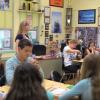The strategies that 12 states used to integrate performance assessment into state systems of assessment.

"Our Kids, Our Future: Privatization and Public Investment in Education" is a 3-minute video explaining the differences between experimental privatization models and public investment in equitable education systems. Policy makers are choosing between these models today. What does research and evidence tell us about the best outcomes for kids?
"How Privatization and Public Investment Influence Education: A Look at the Research" is a 12-minute video on the differences between experimental privatization models and public investment in equitable education systems. The video examines three pairs of countries - Chile and Cuba, Sweden and Finland, and Canada and the U.S. - with one country in each pair privatizing and the other using a public investment model in education.
“Privatization or Public Investment in Education?” is a research and policy brief by Frank Adamson that presents key findings and policy recommendations from Global Education Reform. It explains the differences behind these approaches and highlights the policies and outcomes in each country.
“Six Countries. Two Educational Strategies. One Consistent Conclusion.” is an infographic that presents the differences in approaches and outcomes between privatization and public investment in education.
"Educational Inequities in the New Orleans Charter School System" is an infographic from SCOPE and the Schott Foundation that explains the impact on students and schools of New Orleans becoming a predominantly charter district after Hurricane Katrina.

The global education market is valued at over $5T, embodying the hopes and aspirations of people everywhere. As a sector, education now faces:
In many cases, the public is largely unaware of this rapidly changing educational landscape, the debate between public and private/market approaches, and the decisions that are being made that affect their children and communities. In this rapidly changing environment, research on the impact of different approaches to educational improvement is available and should be included in discussions and policy decisions.
A new book, Global Education Reform: How Privatization and Public Investment Influence Education Outcomes, provides a powerful analysis of these different ends of an ideological spectrum – from market-based experiments to strong state investments in public education. Written by education researchers, the authors compare the privatization and public investment approaches to education in three pairs of countries: Chile and Cuba, Sweden and Finland, and the U.S. and Canada. The book consolidates the best available evidence on the implementation issues and specific results of these different approaches.
An introductory chapter offers an overview of the theories guiding both neoliberal reforms such as those implemented in Chile, Sweden and the United States with efforts to build strong and equitable public education systems as exemplified by Cuba, Finland and Canada. The pairs of country case studies that follow examine the historical evolution of education within individual countries and compare and contrast national educational outcomes. A concluding chapter dissects the educational outcomes of the differing economic and governance approaches, as well as the policy implications.
With contributions by Michael Fullan, Pasi Sahlberg, and Martin Carnoy, and edited by Frank Adamson, Björn Åstrand, and Linda Darling-Hammond, Education Reform is an eye-opening analysis of national educational reforms and the types of high-achieving systems needed to serve all students equitably.
The Editors
Review of This Book
"Global Education Reform is a valuable addition to the conversations on education reform worldwide. The lessons learned after more than three decades of neoliberal reform have been well documented and are poised to inform future reform initiatives."—Teachers College Record
The New Orleans Experiment
New Orleans provides a model for examining the feasibility of a nearly 100% charter, market based system of schools. This is truly an education experiment on a grand scale, and because New Orleans’ system is unique, the nation is watching. How is it working?
A recent SCOPE study examines the New Orleans experiment in terms of the experiences of students and families managing their way through a portfolio of charter schools. Among many findings, the research shows that New Orleans reforms have created a set of schools that are highly stratified by race, class, and educational advantage, operating in a hierarchy that provides very different types of schools and to different types of children. While some have choice; others do not.
The report, “Whose Choice? Student Experiences and Outcomes in the New Orleans School Marketplace,” by Frank Adamson, Channa Cook-Harvey, and Linda Darling-Hammond, and a 12-page research brief are available for free download.
The strategies that 12 states used to integrate performance assessment into state systems of assessment.

Overview of the Instructional Leadership Corps (ILC). Hear from ILC participants and partners on how the ILC project is inspiring students and making an impact through collaboration.
A new book, Global Education Reform: How Privatization and Public Investment Influence Education Outcomes, provides a powerful analysis of these different ends of an ideological spectrum – from market-based experiments to strong state investments in public education.
Sign up for our free newsletter to learn about new SCOPE publications and upcoming events.
© Stanford University, Stanford, California 94305.
